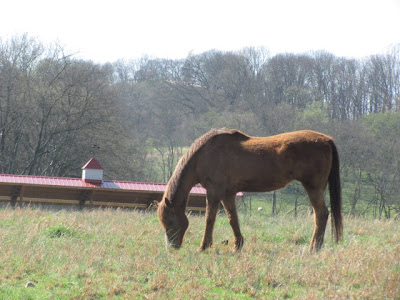In the past couple of weeks I've had some interesting conversations with one of our vets, one of our farriers, and also with a good horse friend of mine. Our conversations have veered onto the subject of aging horses, and how some horses age better than others. These conversations continued to percolate in the back of my mind and I've spent a lot of time thinking about it and reviewing the notes I've kept over the last few years.
Undoubtedly I will get my hand slapped from a few people for some of my thoughts on the subject but these are just my honest observations from living with a lot of aging horses. Everyone wants their older horse to still look like he/she is 10 years old. Some of them do age very gracefully and look amazing, especially given their ages, until they pass on. Others simply don't age as well, and although their health is perfectly acceptable you can look at them and easily know you are looking at an older horse. Below are a few of my observations on this topic.
When we first meet a horse in person if I note certain things I know the odds are very high that they are going to be one that doesn't look like they are 10 when they are 25 or 30:
1. Long backed horses: In my observations the longer backed the horse the more likely it is that their backs will drop, and it will happen at a younger age. Dropped backs often eventually turn into sway backs. Obviously not all long backed horses will develop a sway back but a higher percentage of them seem to compared to their shorter backed counterparts. There is absolutely nothing physically wrong with a horse that has a dropped or swayed back, but of course from a visual standpoint a nice, solid topline is a lot more appealing.
2. Horses with a downhill build: Like the long backed horses mentioned above, horses with a down hill build seem to be more likely to have their backs start to drop at an earlier age. This is probably because due to their conformation they aren't naturally going to lift elevate their front end and work their topline muscles as they gallivant around in the pasture.
3. Horses with straight hind legs: Again these horses seem much more prone to dropped backs and sway backs, again probably due to the way they are naturally going to use themselves as they move about on their own. I should mention that often with a dropped or swayed back these horses tend to get the pot belly look due to their ribcages getting somewhat sprung. Not only are the muscles along the topline not as tight as they once were, but the ones around the ribcage tend to relax as well and their bellies get bigger and bigger as the ribcage gets bigger. This, in my opinion, is the hardest physical thing for the owners to deal with from an aesthetic viewpoint simply because their ribcages can get so sprung that it doesn't matter how much weight you have on them you can't cover their ribs. The horses would have to be over the top obese to get a full layer of fat over their giant ribcage.
4. Horses with naturally "spiny" backs. You know what I mean, horses that are in good flesh and being ridden properly front to back over their toplines so the topline has plenty of muscle and flesh yet things still look a little pointy up top. If they have that look while in correct work it will only get more pronounced when they aren't being ridden and doing forced exercise to build and maintain muscle along their toplines.
5. Thoroughbreds and also warmbloods with a high percentage of thoroughbred blood. I know I will probably get blasted for this one but the truth is that in my (pretty extensive) experience thoroughbreds, and warmbloods with a high percentage of thoroughbred blood, often don't seem to age as gracefully as other breeds. Just so everyone is reading for comprehension I'm NOT saying that every thoroughbred does not age well, of course many of them do, I've lived with them. I AM saying that when I reflect upon the older horses I've lived with, it seems that the thoroughbreds (and warmbloods with a lot of thoroughbred blood) seem to have a much higher percentage of their population that doesn't age as gracefully as we all want them too. They are much more likely to become hard keepers as they age, even if they were easy keepers when younger.
Interestingly when I look over my dental records for all of the horses this group (thoroughbreds and warmbloods with a lot of thoroughbred blood) also has a higher percentage of their population whose teeth don't seem to age as well. Compared to the other breeds on our farm this group of horses is much more likely to have dental issues such as overly worn, loose and missing teeth at younger ages when compared to say the Quarter Horses, Arabians, or the old style warmbloods.
So there you have it, a few of my rambling observations about aging horses.
__________________________________
Faune, Romeo, Fonzi and Chimano. The leaves on the trees in the background are getting ready to explode. In a couple of days this picture will look completely different.

Silky











3 comments:
Interesting insights. =)
Let's not compare how people age, though, shall we? I fear I fall in to the "old warmblood" category in heavy looks and easy feeding, but otherwise, it ain't pretty.
how many of us have the sample size you do, and the years with that size?
you are more than qualified to make these assessments.
your blog, i love it.
I'm glad at least someone thinks that Lytha - thanks!
Post a Comment